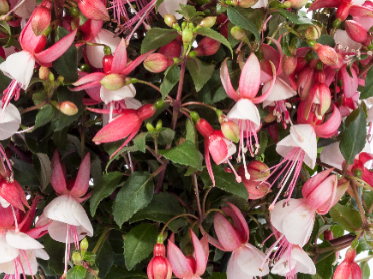
Crop Culture Report: Fuchsia Windchimes Upright Series
Fuchsias bring forth a bit of nostalgia for those of us old enough to remember our grandparents and parents purchasing plants to brighten their porches and balconies. The fuchsia Windchimes will develop a new group of gardening fans with its improved performance and color selection.
The fuchsia's long and colorful history dates back to the late 1600s, when Charles Plumier named his newly discovered genus after a fellow botanist, Leonhart Fuchs. Today there are over 100 recognized species native to tropical or subtropical areas, mostly from the cooler, more temperate parts of South and Central America.
Three centuries and hundreds of cultivars after its beginnings as a cultivated ornamental, the fuchsia remained primarily a shade plant for cooler locations, as most of the breeding had been done in the typically overcast, temperate conditions of the United Kingdom. The introduction of the fuchsia Windchimes in 1998 represented a breeding breakthrough in this plant's tolerance to heat and higher light conditions. The new series was able to sustain growth through the summer months and in sunnier areas of the garden. The Windchimes' genetics were also a breakthrough for their early flowering, their well-branched plant habit, and the ease with which they could be grown, handled and shipped on a commercial scale. Growers now had the ability to ship blooming, manageable Windchimes in early spring and bench run the entire crop.
The new Windchimes Upright series from Green Fuse Botanicals represents another jump forward in fuchsia breeding. Their more mounded, upright plant form is ideal for production in 5- to 12-inch containers, and all colors in the series are uniform in flower response and plant habit. Windchimes Uprights are early to bloom and have larger, more double flowers on robust plants, as compared to the Diva Series which they replace. Together these traits make Windchime Uprights a guaranteed eye-catcher either on their own or in mixed container plantings.
Crop Scheduling and Timing
We suggest pinching at the liner stage to establish lateral shoots low on the stem. This limits the number of times the plants have to be handled. The above guidelines offer weeks to root and pinching timeframe. The Windchimes Uprights will not require any additional pinches to finish a quality plant.
Irrigation and Fertilization
Transplant rooted liners in a well-drained soil mix. Best results occur when soil is kept evenly moist, but not constantly saturated.
Maintain a soil pH range of 6.0 to 6.5. Feed requirements for fuchsia are low so irrigating with a prepared calcium/magnesium, low ammonium feed at 100- to 200-ppm nitrogen on a constant basis is best. A proper EC level for a soilless mix is 0.75 to 1.0.
Temperature and Light Levels
Temperatures are best delivered as 70 to 85¡ F days and 62 to 65¡ F nights.
A negative DIF delivered as part of the temperature regime would be beneficial in controlling internode stretch. In warm temperature regions like Florida, Windchimes fuchsia will form a "crown-bud" if grown in full sun with no shading. They will set buds and bypass the bud with new growth, never developing full color. We believe this is a heat-delay type of response.
It is recommended that Windchimes be grown under partial shade during high light times of the year to reduce leaf temperatures.
Early spring light levels are not a concern unless leaf temperatures increase to the point of stressing the plant, which will reduce plant growth, or if extreme fluctuations in soil moisture are allowed to occur it can result in damage to flowers or foliage. During the late spring and early summer, reduce light levels to 1,200 to 1,400 foot-candles to reduce growing temperatures.
Growth Regulators
Under warm or low-light conditions, B-Nine is effective in controlling stretch (1,250 to 2,500 ppm rate). In warm temperature regions, products like Sumagic and Topflor are more effective in controlling height. Use at labeled rates, and as standard procedure it is always best to trial small groups of plants to discover the optimal rate for your growing environment. Bonzi drenches at 2 to 3 ppm are highly effective. Multiple applications of Bonzi will reduce flower size.
Disease and Insect Pests
Aphids, Spider Mites, and Whitefly are typically the most common pests of fuchsia. Scouting for these insects and using a preventative spray program will keep the plants clean for a quality finished product.
Botrytis, Pythium and Rhizoctonia are the diseases of greatest concern. Damage to Fuchsia stems will create entry for disease pathogens. Fuchsias are susceptible to crown rot (Rhizoctonia) if rooted liners are transplanted too deeply resulting in covered stems, or if excessive soil is built up around crown. To control Pythium and Phytophthora, a preventative fungicide drench is recommended shortly after transplant. Maintain good air movement around plants for control of Botrytis or other foliar diseases. Avoid watering plants late in the day; as with most plants, it is best to enter the evening hours with dry foliage and stems.
Crop Culture Report: Fuchsia Windchimes Upright Series


 Video Library
Video Library 




















